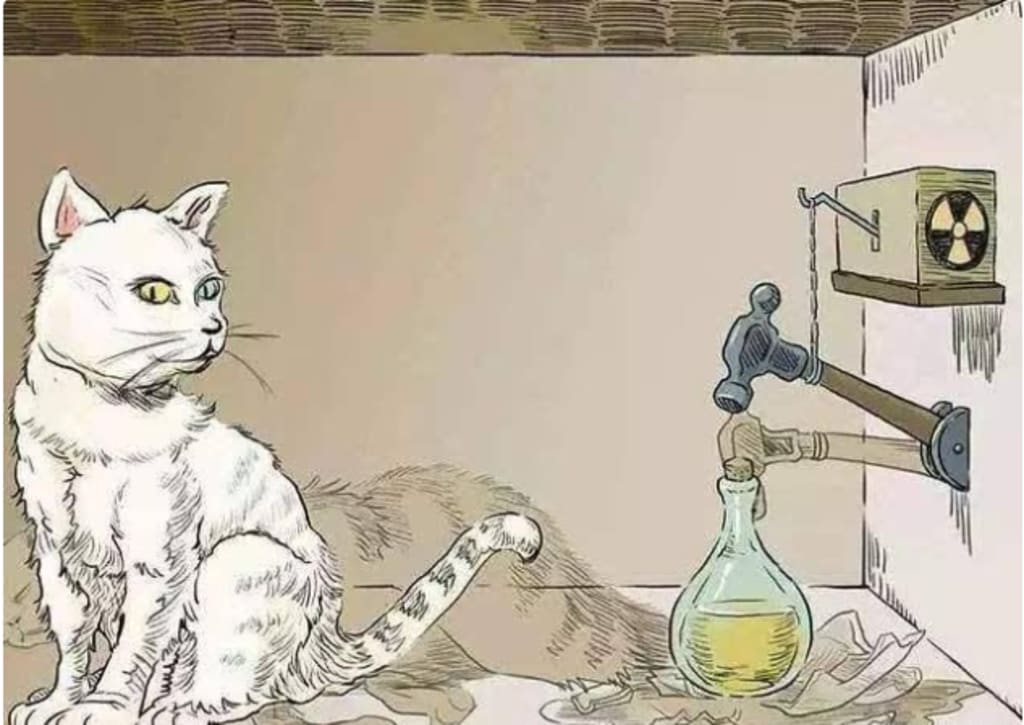
Schrödinger's cat is the most famous in science because he explained the baffling quantum mechanics to everyone through his own life and death. Let's start with what Schrödinger's cat is and how it explains quantum mechanics for us.
First of all, Schrödinger's cat is not a real cat, but a hypothetical cat in the thought experiment Schrödinger used to explain quantum mechanics. Who is this Schrödinger? To be honest, when I first saw the name, I kept thinking it was a Chinese guy called Xue, but it wasn't.)
Schrödinger, whose full name is Erwin Rudolf Joseph Alexander Schrödinger (the name is a bit long), is an Austrian physicist and the most important founder of quantum mechanics. Quantum mechanics has two manifestations, wave dynamics, and matrix mechanics, with wave dynamics being established by Schrödinger.
He also established Schrödinger's equation, the fundamental law of quantum mechanics describing the state of motion of microscopic particles, and the basis for wave dynamics. His achievements in quantum mechanics are equivalent to Newton's in classical mechanics.
In addition to his great contributions to quantum mechanics, he also developed molecular biology and made some achievements in philosophy. Schrödinger's achievements were not, however, original. He was very keen to discover the innovative ideas of others to develop and build systems that eventually led to a theory. (These are Schrödinger's own words)
Schrödinger postulated a cat and a device in an airtight container. The top half of this device is a relay containing a small amount of radium and connected to a hammer, and the bottom half is a bottle containing cyanide. Whenever a small amount of radium decays in the upper part, it triggers the relay to drop the hammer and smash the bottle containing cyanide. The cat will die after inhaling the cyanide vapor. The probability of radium decay is 50%, which means that the cat has a 50% chance of surviving.
It is not known when the radium decays. It could be a second before we open the container or a second after we open it. Because this container is closed, we cannot see directly inside the container. Only when the container is opened, that is, when we are looking, can we determine whether the cat is dead or alive.
From the point of view of quantum mechanics, the cat's state of existence is co-existent. As long as we do not open this closed container and observe it, the cat is both alive and dead. It is only when the container is opened that we see the 'real state of the cat. The establishment of one state also means that the other state has collapsed. (Simply put, life and death are like two standing signs. When you see a cat, the sign representing the corresponding state is still standing, while the other sign has been pushed down.)
From our everyday perception, a thing or an event needs to have a definite outcome, it is what it is. This is the macroscopic perspective to analyze problems and things, but quantum mechanics is the discipline of the microscopic world, which is very different from the macroscopic world.
This experiment only explains the superposition state of the microscopic world for us through the macroscopic cat. We who are used to the macroscopic world always think presently when we encounter anything and problems, so it is inevitable that we are skeptical about some amazing phenomena in the microscopic world, or even think that it is impossible.
However, the world is such an amazing place that we can't just stand still and look at the sky. We need to expand our minds, question everything and then seek the truth. However, does the truth matter? The so-called truth is just the organization of your intellectual memory. As new information enters your intellectual memory, the truth may change accordingly. There is no truth in the world. What is wanted within is the truth. Does this paragraph seem contradictory, but confusing?
It's too far. Go around. Quantum mechanics, the branch of physics that studies the laws of motion of microscopic particles in the material world, has opened another door to the world and laid the foundations for modern physics. But we are still exploring it because it is not as intuitively understandable as the macroscopic world. Ordinary people have little exposure to it, so it is even harder to understand.
If one day in the future, quantum mechanics is applied to our daily life and brings us convenience, then it will be easier for us to understand. For now, we don't have to worry about this, we just need to find out if we are interested. For the basics, the macroscopic content is enough for us.
I feel it is a summary of the main points :
1. Schrödinger's cat is not a real cat, but the cat postulated in the thought experiment Schrödinger proposed to explain quantum mechanics.
Schrödinger, whose full name is Erwin Schrödinger, is an Austrian physicist and the most important founder of quantum mechanics. Quantum mechanics has two manifestations, wave dynamics, and matrix mechanics, with wave dynamics being established by Schrödinger. He also established Schrödinger's equation, which is the fundamental law of quantum mechanics describing the state of motion of microscopic particles and the basis for wave dynamics. His achievements in quantum mechanics are equivalent to Newton's in classical mechanics. In addition to his great contributions to quantum mechanics, he also developed molecular biology and made some achievements in philosophy.
3. Schrödinger's cat is a cat in an airtight container with a device that has a 50% chance of killing the cat, the trigger time is not yet known. Because we cannot see inside the closed container, the only way to see the cat's life or death state is to open the container, otherwise, the cat would have both life and death states.
4. We cannot understand the wonderful phenomena of the microscopic world because we always see everything from a macroscopic point of view, a kind of inertial thinking. But this is not right. We need to expand our thinking and explore the truth while questioning things.
5. There is no truth in the world. What is wanted within is the truth.
6. It is beneficial for people interested in quantum mechanics to know about it. The average person will not use it and there is no need to dwell on it.
About the Creator
Roseto
Science and civilization show that too much information sometimes gets in the way of knowledge and innovation。






Comments
There are no comments for this story
Be the first to respond and start the conversation.